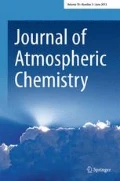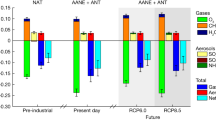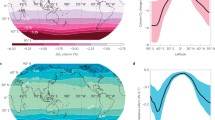Abstract
Halogenated Very Short-lived Substances (VSLS), such as bromoform, dibromomethane and methyl iodide, are naturally produced in the oceans and are involved in ozone depletion in the troposphere and the stratosphere. The effect of climate change on the oceanic emissions of these compounds is not well quantified. Based on present-day observed global oceanic and atmospheric concentrations, and historic and future data from three CMIP5 models, past and future sea-to-air fluxes of these VSLS are calculated. The simulations are used to infer possible effects of projected changes of physical forcing on emissions in different oceanic regimes. CMIP5 model output for 1979–2100 from the historical scenario and the RCP scenarios 2.6 and 8.5 are used as input data for the emission calculations. Of the parameters that have the main influence on the sea-to-air fluxes, the global sea surface temperatures show a steady increase during the twenty-first century, while the projected changes of sea surface wind speed is very small. The calculated emissions based on the historical CMIP5 model runs (1979–2005) increased over the 26 year period and agree well with the emissions based on ERA-Interim data. The future sea-to-air fluxes of VSLS generally increase during the twenty-first century under the assumption of constant concentration fields in the ocean and atmosphere. The multi-model mean global emissions of bromoform increase by 29.4% (9.0%) between 1986 and 2005 and 2081–2100 under RCP 8.5 (2.6) and dibromomethane and methyl iodide emissions increase by 23.3% (6.4%) and 5.5% (1.5%), respectively. Uncertainties of the future emission estimates, driven by ongoing environmental changes such as changing oceanic productivity (not considered in this study) are discussed.





Similar content being viewed by others
References
Antonov, J.I., Seidov, D., Boyer, T.P., Locarnini, R.A., Mishonov, A.V., Garcia, H.E., Baranova, O.K., Zweng, M.M., Johnson, D.R.: World ocean atlas 2009, volume 2: salinity. In: Levitus, S. (ed.) NOAA atlas NESDIS 69, p. 184. U.S. Government Printing Office, Washington, D.C. (2010)
Aschmann, J., Sinnhuber, B.M., Atlas, E.L., Schauffler, S.M.: Modeling the transport of very short-lived substances into the tropical upper troposphere and lower stratosphere. Atmos. Chem. Phys. 9, 9237–9247 (2009)
Bopp, L., Resplandy, L., Orr, J.C., Doney, S.C., Dunne, J.P., Gehlen, M., Halloran, P., Heinze, C., Ilyina, T., Seferian, R., Tjiputra, J., Vichi, M.: Multiple stressors of ocean ecosystems in the twenty-first century: projections with CMIP5 models. Biogeosciences. 10, 6225–6245 (2013). doi:10.5194/bg-10-6225-2013
Carpenter L.J., Reimann, S., Burkholder, J.B., Clerbaux, C., Hall, B.D., Hossaini, R., Laube, J.C., Yvon-Lewis, S.A.: Ozone-depleting substances (ODSs) and other gases of interest to the Montreal protocol, chapter 1 in scientific assessment of ozone depletion: 2014, Global Ozone Research and Monitoring Project-Report No. 55, World Meteorological Organization, Geneva, Switzerland (2014)
Collins, M., Knutti, R., Arblaster, J., Dufresne, J.-L., Fichefet, T., Friedlingstein, P., Gao, X., Gutowski, W.J., Johns, T., Krinner, G., Shongwe, M., Tebaldi, C., Weaver, A.J., Wehner, M.: Long-term climate change: projections, commitments and irreversibility. In: Stocker, T.F., Qin, D., Plattner, G.-K., Tignor, M., Allen, S.K., Boschung, J., Nauels, A., Xia, Y., Bex, V., Midgley, P.M. (eds.) Climate change 2013: the physical science basis. Contribution of working group I to the fifth assessment report of the intergovernmental panel on climate change. Cambridge University Press, Cambridge, United Kingdom and New York, NY, USA (2013)
Dee, D.P., Uppala, S.M., Simmons, A.J., Berrisford, P., Poli, P., Kobayashi, S., Andrae, U., Balmaseda, M.A., Balsamo, G., Bauer, P., Bechtold, P., Beljaars, A.C.M., van de Berg, L., Bidlot, J., Bormann, N., Delsol, C., Dragani, R., Fuentes, M., Geer, A.J., Haimberger, L., Healy, S.B., Hersbach, H., Holm, E.V., Isaksen, L., Kallberg, P., Koehler, M., Matricardi, M., McNally, A.P., Monge-Sanz, B.M., Morcrette, J.J., Park, B.K., Peubey, C., de Rosnay, P., Tavolato, C., Thepaut, J.N., Vitart, F.: The ERA-interim reanalysis: configuration and performance of the data assimilation system. Q. J. R. Meteorol. Soc. 137, 553–597 (2011). doi:10.1002/qj.828
Dessens, O., Zeng, G., Warwick, N., Pyle, J.: Short-lived bromine compounds in the lower stratosphere; impact of climate change on ozone. Atmos. Sci. Lett. 10, 201–206 (2009). doi:10.1002/asl.236
Dix, B., Baidar, S., Bresch, J.F., Hall, S.R., Schmidt, K.S., Wang, S., Volkamer, R.: Detection of iodine monoxide in the tropical free troposphere. P. Natl. Acad. Sci. USA. 110, 2035–2040 (2013). doi:10.1073/pnas.1212386110
Doney, S.C.: The growing human footprint on coastal and Open-Ocean biogeochemistry. Science. 328, 1512–1516 (2010). doi:10.1126/science.1185198
Flato, G., Marotzke, J., Abiodun, B., Braconnot, P., Chou, S.C., Collins, W., Cox, P., Driouech, F., Emori, S., Eyring, V., Forest, C., Gleckler, P., Guilyardi, E., Jakob, C., Kattsov, V., Reason, C., Rummukainen, M.: Evaluation of climate models. In: Stocker, T.F., Qin, D., Plattner, G.-K., Tignor, M., Allen, S.K., Boschung, J., Nauels, A., Xia, Y., Bex, V., Midgley, P.M. (eds.) Climate change 2013: the physical science basis. Contribution of working group I to the fifth assessment report of the intergovernmental panel on climate change, pp. 741–866. Cambridge University Press, Cambridge, United Kingdom and New York, NY, USA (2013). doi:10.1017/CBO9781107415324.020
Giorgetta, M.A., Jungclaus, J., Reick, C.H., Legutke, S., Bader, J., Böttinger, M., Brovkin, V., Crueger, T., Esch, M., Fieg, K., Glushak, K., Gayler, V., Haak, H., Hollweg, H.-D., Ilyina, T., Kinne, S., Kornblueh, L., Matei, D., Mauritsen, T., Mikolajewicz, U., Mueller, W., Notz, D., Pithan, F., Raddatz, T., Rast, S., Redler, R., Roeckner, E., Schmidt, H., Schnur, R., Segschneider, J., Six, K.D., Stockhause, M., Timmreck, C., Wegner, J., Widmann, H., Wieners, K.-H., Claussen, M., Marotzke, J., Stevens, B.: Climate and carbon cycle changes from 1850 to 2100 in MPI-ESM simulations for the Coupled Model Intercomparison Project phase 5. J. Adv. Model. Earth Syst. 5(3),572–597 (2013).
Hense, I., Quack, B.: Modelling the vertical distribution of bromoform in the upper water column of the tropical Atlantic Ocean. Biogeosciences 6(4), 535–544 (2009).
Hepach, H., Quack, B., Ziska, F., Fuhlbrügge, S., Atlas, E.L., Krüger, K., Peeken, I., Wallace, D.W.R.: Drivers of diel and regional variations of halocarbon emissions from the tropical north East Atlantic. Atmos. Chem. Phys. 14, 1255–1275 (2014). doi:10.5194/acp-14-1255-2014
Hopkins, F.E., Kimmance, S.A., Stephens, J.A., Bellerby, R.G.J., Brussaard, C.P.D., Czerny, J., Schulz, K.G., Archer, S.D.: Response of halocarbons to ocean acidification in the Arctic. Biogeosciences. 10, 2331–2345 (2013). doi:10.5194/bg-10-2331-2013
Hossaini, R., Chipperfield, M.P., Dhomse, S., Ordonez, C., Saiz-Lopez, A., Abraham, N.L., Archibald, A., Braesicke, P., Telford, P., Warwick, N., Yang, X., Pyle, J.: Modelling future changes to the stratospheric source gas injection of biogenic bromocarbons. Geophys. Res. Lett. 39, (2012). doi:10.1029/2012gl053401
Hossaini, R., Chipperfield, M.P., Montzka, S.A., Rap, A., Dhomse, S., Feng, W.: Efficiency of short-lived halogens at influencing climate through depletion of stratospheric ozone. Nat. Geosci. 8, 186–190 (2015). doi:10.1038/ngeo2363
Hughes, C., Johnson, M., von Glasow, R., Chance, R., Atkinson, H., Souster, T., Lee, G., Clarke, A., Meredith, M., Venables, H., Turner, S., Malin, G., Liss, P.: Climate-induced change in biogenic bromine emissions from the Antarctic marine biosphere. Global Biogeochem. Cy. 26, GB3019 (2012). doi:10.1029/2012GB004295
Hughes, C., Johnson, M., Utting, R., Turner, S.M., Clarke, A., Malin, G., Liss, P.: Microbial control of bromocarbon concentrations in coastal waters of the western Antarctic peninsula. Mar. Chem. 151, 35–46 (2013)
IPCC: Contribution of working group I to the fifth assessment report of the intergovernmental panel on climate change. In: Stocker, T.F., Qin, D., Plattner, G.-K., Tignor, M., Allen, S.K., Boschung, J., Nauels, A., Xia, Y., Bex, V., Midgley, P.M. (eds.) Climate change 2013: the physical science basis, p. 1535. Cambridge University Press, Cambridge, United Kingdom and New York, NY, USA (2013). doi:10.1017/CBO9781107415324
Jones, C.D., Hughes, J.K., Bellouin, N., Hardiman, S.C., Jones, G.S., Knight, J., Liddicoat, S., O’Connor, F.M., Andres, R.J., Bell, C., Boo, K.-O., Bozzo, A., Butchart, N., Cadule, P., Corbin, K.D., Doutriaux-Boucher, M., Friedlingstein, P., Gornall, J., Gray, L., Halloran, P.R., Hurtt, G., Ingram, W.J., Lamarque, J.-F., Law, R.M., Meinshausen, M., Osprey, S., Palin, E.J., Parsons Chini, L., Raddatz, T., Sanderson, M.G., Sellar, A.A., Schurer, A., Valdes, P., Wood, N., Woodward, S., Yoshioka, M., Zerroukat, M.: The HadGEM2-ES implementation of CMIP5 centennial simulations. Geosci. Model Dev. 4(3), 543–570 (2011).
Karlsson, A., Theorin, M., Abrahamsson, K.: Distribution, transport, and production of volatile halocarbons in the upper waters of the ice-covered high Arctic Ocean. Global Biogeochem. Cy. 27, 1246–1261 (2013). doi:10.1002/2012GB004519
Laufkötter, C., Vogt, M., Gruber, N., Aita-Noguchi, M., Aumont, O., Bopp, L., Buitenhuis, E., Doney, S.C., Dunne, J., Hashioka, T., Hauck, J., Hirata, T., John, J., Le Quéré, C., Lima, I.D., Nakano, H., Seferian, R., Totterdell, I., Vichi, M., Völker, C.: Drivers and uncertainties of future global marine primary production in marine ecosystem models. Biogeosciences Discuss. 12, 3731–3824 (2015). doi:10.5194/bgd-12-3731-2015
Liang, Q., Atlas, E., Blake, D., Dorf, M., Pfeilsticker, K., Schauffler, S.: Convective transport of very short lived bromocarbons to the stratosphere. Atmos. Chem. Phys. 14, 5781–5792 (2014). doi:10.5194/acp-14-5781-2014
Lin, C.Y., Manley, S.L.: Bromoform production from seawater treated with bromoperoxidase. Limnol. Oceanogr. 57, 1857–1866 (2012). doi:10.4319/1o.2012.57.06.1857
Liu, Y.N., Thornton, D.C.O., Bianchi, T.S., Arnold, W.A., Shields, M.R., Chen, J., Yvon-Lewis, S.A.: Dissolved organic matter composition drives the marine production of brominated very short-lived substances. Environ. Sci. Technol. 49, 3366–3374 (2015). doi:10.1021/es505464k
Mattson, E., Karlsson, A., Smith, W., Abrahamsson, K.: The relationship between biophysical variables and halocarbon distributions in the waters of the Amundsen and Ross seas, Antarctica. Mar. Chem. 140–141, 1–9 (2012)
McFiggans, G., Plane, J. M. C., Allan, B. J., Carpenter, L. J., Coe, H., and O’Dowd, C.: A modeling study of iodine chemistry in the marine boundary layer. J. Geophys. Res.-Atmos. 105, 14371–14385 (2000). doi:10.1029/1999JD901187
Meehl G.A., Washington W.M., Arblaster J.M., Hu A., Teng H., Kay J.E., Gettelman A., Lawrence D.M., Sanderson B.M., Strand W.G.: Climate change projections in CESM1 (CAM5) compared to CCSM4. J. Clim. 26(17),6287–6308 (2013).
Neale, R.B., Richter, J., Park, S., Lauritzen, P.H., Vavrus, S.J., Rasch, P.J., Zhang, M.: The mean climate of the community atmosphere model (CAM4) in forced SST and fully coupled experiments. J. Clim. 26(14), 5150–5168 (2013).
Nightingale, P.D., Malin, G., Law, C.S., Watson, A.J., Liss, P.S., Liddicoat, M.I., Boutin, J., Upstill-Goddard, R.C.: In situ evaluation of air-sea gas exchange parameterizations using novel conservative and volatile tracers. Glob. Biogeochem. Cycle. 14, 373–387 (2000). doi:10.1029/1999gb900091
Pyle, J.A., Warwick, N., Yang, X., Young, P.J., Zeng, G.: Climate/chemistry feedbacks and biogenic emissions. Philos. Trans. R. Soc. A-Math. Phys. Eng. Sci. 365, 1727–1740 (2007). doi:10.1098/rsta.2007.2041
Quack, B., Wallace, D.: Air-sea flux of bromoform: controls, rates, and implications. Global Biogeochem. Cycles 17, 1023 (2003). doi:10.1029/2002GB001890
Quack, B., Atlas, E., Petrick, G., Wallace, D.W.R.: Bromoform and dibromomethane above the Mauritanian upwelling: atmospheric distributions and oceanic emissions. J. Geophys. Res. 112, D09312 (2007). doi:10.1029/2006JD007614
Richter, U., Wallace, D.W.R.: Production of methyl iodide in the tropical Atlantic Ocean. Geophys. Res. Lett. 31(23), L23S03 (2004). doi:10.1029/2004GL020779
Saiz-Lopez, A., von Glasow, R.: Reactive halogen chemistry in the troposphere. Chem. Soc. Rev. 41, 6448–6472 (2012). doi:10.1039/c2cs35208g
Saiz-Lopez, A., Plane, J.M.C., Baker, A.R., Carpenter, L.J., von Glasow, R., Martin, J.C.G., McFiggans, G., Saunders, R.W.: Atmospheric chemistry of iodine. Chem. Rev. 112, 1773–1804 (2012). doi:10.1021/cr200029u
Saiz-Lopez, A., Baidar, S., Cuevas, C.A., Koenig, T.K., Fernandez, R.P., Dix, B., Kinnison, D.E., Lamarque, J.-F., Rodriguez-Lloveras, X., Campos, T.L., Volkamer, R.: Injection of iodine to the stratosphere. Geophys. Res. Lett. 42(16), 6852–6859 (2015).
Sinnhuber, B.-M., Sheode, N., Sinnhuber, M., Chipperfield, M.P., Feng, W.: The contribution of anthropogenic bromine emissions to past stratospheric ozone trends: a modelling study. Atmos. Chem. Phys. 9, 2863–2871 (2009). doi:10.5194/acp-9-2863-2009
Solomon, S., Garcia, R.R., Ravishankara, A.R.: On the role of iodine in ozone depletion. J. Geophys. Res. 99(D10), 20491–20499 (1994). doi:10.1029/94JD02028
Stemmler, I., Hense, I., Quack, B.: Marine sources of bromoform in the global open ocean – global patterns and emissions. Biogeosciences, 12, 1967–1981 (2015). doi:10.5194/bg-12-1967-2015.
Taucher, J., Oschlies, A.: Can we predict the direction of marine primary production change under global warming? Geophys. Res. Lett. 38, L02603 (2011). doi:10.1029/2010GL045934
Taylor, K.E., Stouffer, R.J., Meehl, G.A.: An overview of CMIP5 and the experiment design. Bull. Am. Meteorol. Soc. 93, 485–498 (2012). doi:10.1175/bams-d-11-00094.1
Tegtmeier, S., Krüger, K., Quack, B., Atlas, E.L., Pisso, I., Stohl, A., Yang, X.: Emission and transport of bromocarbons: from the West Pacific Ocean into the stratosphere. Atmos. Chem. Phys. 12(22), 10633–10648 (2012). doi:10.5194/acp-12-10633-2012
Tegtmeier, S., Krüger, K., Quack, B., Atlas, E., Blake, D.R., Boenisch, H., Engel, A., Hepach, H., Hossaini, R., Navarro, M.A., Raimund, S., Sala, S., Shi, Q., Ziska, F.: The contribution of oceanic methyl iodide to stratospheric iodine. Atmos. Chem. Phys. 13, 11869–11886 (2013). doi:10.5194/acp-13-11869-2013
Tegtmeier, S., Ziska, F., Pisso, I., Quack, B., Velders, G.J.M., Yang, X., Krüger, K.: Oceanic bromoform emissions weighted by their ozone depletion potential. Atmos. Chem. Phys. 15, 13647–13663 (2015). doi:10.5194/acp-15-13647-2015
van Vuuren, D.P., Edmonds, J., Kainuma, M., Riahi, K., Thomson, A., Hibbard, K., Hurtt, G.C., Kram, T., Krey, V., Lamarque, J.-F., Masui, T., Meinshausen, M., Nakicenovic, N., Smith, S.J., Rose, S.K.: The representative concentration pathways: an overview. Clim. Chang. 109, 5–31 (2011). doi:10.1007/s10584-011-0148-z
von Glasow, R., von Kuhlmann, R., Lawrence, M.G., Platt, U., Crutzen, P.J.: Impact of reactive bromine chemistry in the troposphere. Atmos. Chem. Phys. 4, 2481–2497 (2004)
Wanninkhof, R.: The effect of using time-averaged winds on regional air-sea CO2 fluxes, in: Gas Transfer at Water Surface. American Geophysical Union 351–357 (2002)
Werschkun, B., Sommer, Y., Banerji, S.: Disinfection by-products in ballast water treatment: an evaluation of regulatory data. Water Res. 46, 4884–4901 (2012). doi:10.1016/j.watres.2012.05.034
Yang, X., Cox, R.A., Warwick, N.J., Pyle, J.A., Carver, G.D., O’Connor, F.M., Savage, N.H.: Tropospheric bromine chemistry and its impacts on ozone: a model study. J. Geophys. Res.-Atmos. 110, D23311 (2005). doi:10.1029/2005jd006244
Yokouchi, Y., Nojiri, Y., Toom-Sauntry, D., Fraser, P., Inuzuka, Y., Tanimoto, H., Nara, H., Murakami, R., Mukai, H.: Longterm variation of atmospheric methyl iodide and its link to global environmental change. Geophys. Res. Lett. 39, L23805 (2012). doi:10.1029/2012GL053695
Ziska, F., Quack, B., Abrahamsson, K., Archer, S.D., Atlas, E., Bell, T., Butler, J.H., Carpenter, L.J., Jones, C.E., Harris, N.R.P., Hepach, H., Heumann, K.G., Hughes, C., Kuss, J., Krüger, K., Liss, P., Moore, R.M., Orlikowska, A., Raimund, S., Reeves, C.E., Reifenhäuser, W., Robinson, A.D., Schall, C., Tanhua, T., Tegtmeier, S., Turner, S., Wang, L., Wallace, D., Williams, J., Yamamoto, H., Yvon-Lewis, S., Yokouchi, Y.: Global Sea-to-air flux climatology for bromoform, dibromomethane and methyl iodide. Atmos. Chem. Phys. 13, 8915–8934 (2013). doi:10.5194/acp-13-8915-2013
Acknowledgements
We would like to thank Ryan Hossaini for his helpful comments during the writing process and Christa Marandino for her comments and editorial work. This work was supported by the European Union under the project SHIVA (Grant No. 226 224), the German Federal Ministry of Education and Research (BMBF) in the project SOPRAN (Grant No: 03F0611A) and the project ROMIC-THREAT (Grant No: 01LG1217A). We acknowledge the World Climate Research Programme’s Working Group on Coupled Modelling, responsible for CMIP, and we thank the climate modeling groups (listed in Table 1 of this paper) for making their model output available. Additionally, we thank the European Centre for Medium-Range Weather Forecasts (ECMWF) for the ERA Interim reanalysis data.
Author information
Authors and Affiliations
Corresponding author
Rights and permissions
About this article
Cite this article
Ziska, F., Quack, B., Tegtmeier, S. et al. Future emissions of marine halogenated very-short lived substances under climate change. J Atmos Chem 74, 245–260 (2017). https://doi.org/10.1007/s10874-016-9355-3
Received:
Accepted:
Published:
Issue Date:
DOI: https://doi.org/10.1007/s10874-016-9355-3




